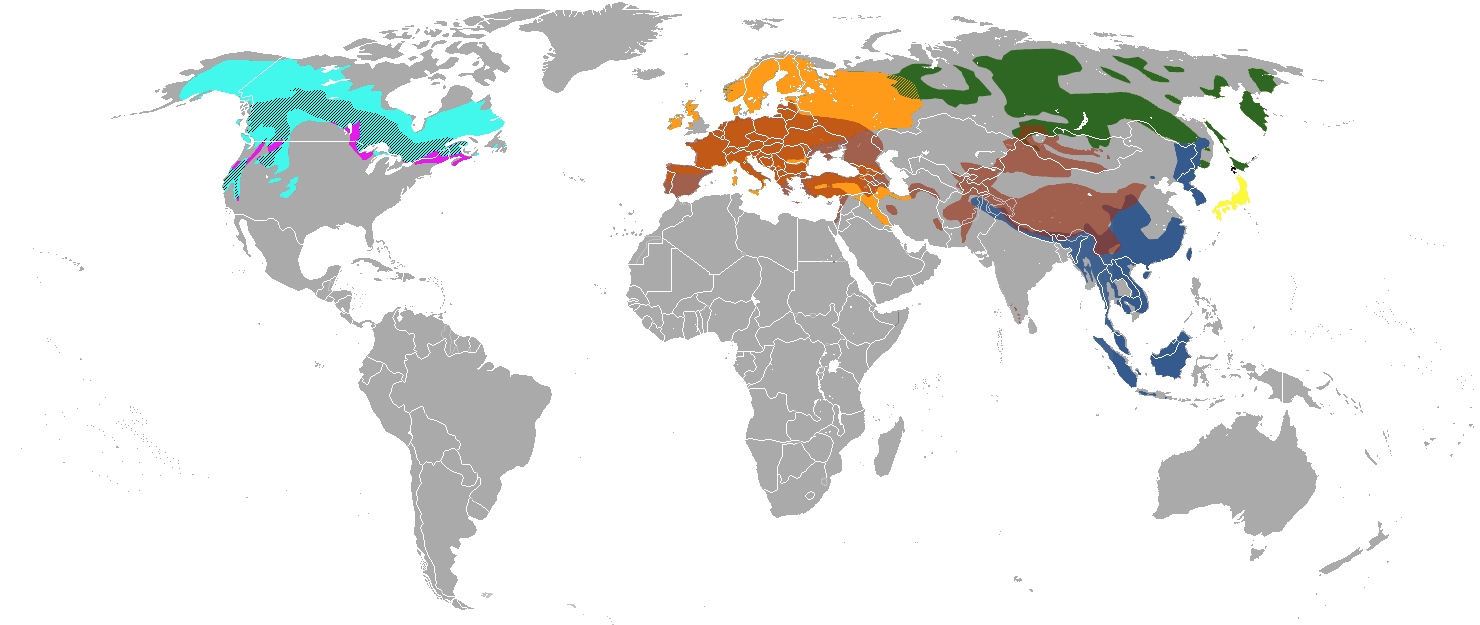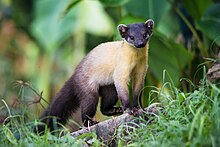Classification
Yellow-throated marten (Martes flavigula), Thailand
- American marten (M. americana)
- Newfoundland pine marten (M. a. atrata)
- Yellow-throated marten (M. flavigula)
- Beech marten (M. foina)
- Nilgiri marten (M. gwatkinsii)
- European pine marten (M. martes)
- Japanese marten (M. melampus)
- Sable (M. zibellina)
- Martes wenzensis†
- Martes nobilis†
Etymology
The Modern English "marten" comes from the Middle English martryn, in turn borrowed from the Anglo-French martrine and Old French martre (Latin martes), itself from a Germanic source; cf. Old English mearþ, Old Norse mörðr, and Old High German and Yiddish מאַרדאַר mardar.Ecology and behaviour
Martens are solitary animals, meeting only to breed in late spring or early summer. Litters of up to five blind and nearly hairless kits are born in early spring. They are weaned after around two months, and leave the mother to fend for themselves at about three to four months of age. Due to their habit of seeking warm and dry places and to gnaw on soft materials, martens cause damage to soft plastic and rubber parts in cars and other parked vehicles, annually costing millions of euros in Central Europe alone, thus leading to the offering of marten-damage insurance, "marten-proofing", and electronic repellent devices.[3][4][5][6] They are omnivorous.Cultural references
Canada
The marten is popular in the northern Ontario community of Big Trout Lake. During the fur trade, commissioned by the Hudson Bay Company in the 17th and 18th centuries, the marten pelt was typically fashioned into mittens. The marten is still traded locally. The locals place a high value on this pelt, typically trading it for consumable goods.[citation needed]Croatia
In the Middle Ages, marten pelts were highly valued goods used as a form of payment in Slavonia, the Croatian Littoral, and Dalmatia. The banovac, a coin struck and used between 1235 and 1384, included the image of a marten. This is one of the reasons why the Croatian word for marten, kuna, is the name of the modern Croatian currency.[7] A marten is depicted on the obverse of the 1-, 2-, and 5-kuna coins, minted since 1993, and on the reverse of the 25-kuna commemorative coins.[8]A running marten is shown on the coat of arms of Slavonia and subsequently on the modern design of the coat of arms of Croatia. The official seal of the Croatian Sabor (parliament) from 1497 until the late 18th century had a similar design.[9][10]
Finland
The Finnish communications company Nokia derives its name, via the river Nokianvirta, from a type of marten locally known as the nokia.[11]Greece
In the Illiad, the fleet-footed spy Dolon wore a marten-pelt cap.Italy
The Latin word for helmet, galea, originally meant "marten pelt," although it is unclear whether early Romans wore these helmets for symbolical reasons or for their fine fur.[12]Martes
Pinel, 1792

Marten ranges:
- M. americana = cyan & teal
- M. flavigula = dark blue & sepia
- M. foina = rust, brown & sepia
- M. gwatkinsii
- M. martes = orange, rust & grass-green
- M. melampus = yellow
- M. pennanti = purple & teal
- M. zibellina = green & grass-gree


No comments:
Post a Comment
Note: Only a member of this blog may post a comment.